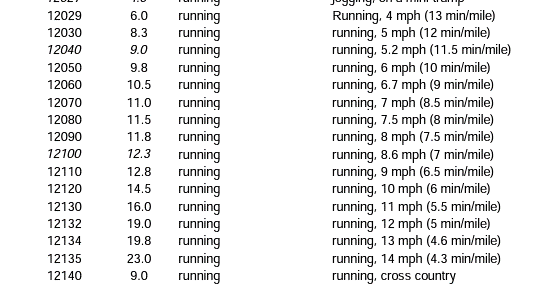Articles > Why is running ineffective for burning fat?
So first of all don't stop running! If you like to run and feel that it is good for you, you are right, it really is good. Running and various kinds of physical activity release large amount of endorphins. Although an interesting study found that if the training is too intense, this increase in endorphins may actually lead to negative emotions. So if you run too fast, you should pay attention to your mood, this will be an indicator that the training is too intense.
Running requires a long time to lose fat mass by burning enough calories. Sometimes eating one less slice of bread a day can give similar results to running 3 times a week. In addition, increasing muscle mass increases our basic metabolic rate (burning calories at rest) and inhibits the generation of fat tissue and is therefore more effective in reducing fat.

2011 Compendium of Physical Activities
If we are dealing with a decrease in fat mass, we want to burn energy (calories).
So how much energy do we burn in physical activity? It depends on four things:
- Type of activity
- Intensity level
- Activity time
- Our body weight
I am translating for you here the table for the energy expenditure of an average person in 10 minutes of running:
Jogging (8 minutes per kilometer) – 1 calorie per kg of body weight.
Moderate running (6.2 min per km) – 1.63 calories per kg of body weight.
Intense running (5 minutes per km) – 1.91 calories per kg of body weight.
So let's take for example, a healthy 35-year-old man who weighs 90 kg that runs for half an hour, 3 times a week at the medium pace detailed above.
In one run he burns 440 calories, in a week 1320 calories. A kg of fat is 7,700 calories and it will take almost 6 weeks to lose 1 kg.
He can do the same thing if he removes 2 slices of bread a day from his diet without moving from his chair. So it's not that running isn't good for us, but it's the least effective thing for losing fat.
Therefore, first of all, we turn to nutrition, which is the strongest and most effective factor for reducing fat mass.
A lot of people get 'stuck' after they change their diet. As a side note, it is worth asking if the change is oriented with the human diet, because it is possible to achieve amazing results with only dietary change.
The next thing if you are stuck with the diet, is to increase the muscle mass through resistance training (and it is better to do this at the same time if possible) – see the muscle benefits in the article 10X stronger exercise.
The muscle is an organ that changes our hormonal composition and body signals with the help of myokines to inhibit fat tissue's building process.
And if we're just talking about health for a moment, then the muscle and its strength are a main component for longevity in good health.
The muscle is also a tissue that serves as a kind of furnace for burning calories. A trained muscle requires a lot of energy even at rest. A kg of muscle burns about 13 calories per day compared to a kg of fat that burns about 5 calories, reducing fat and adding muscle will increase the daily calorie expenditure significantly. In addition, the more trained a muscle is, the more glucose receptors (GLUT4) it has on the cells surface and its sensitivity to insulin is better. As a result, muscles consumes more sugar from the blood, which prevents it from being stored in the fat tissue and building it.
Burning energy in the body (or its metabolic rate) includes 4 components:
1. Basal metabolic rate – all the autonomous actions of the body – body temperature, the immune system and the various body functions.
2. Activity that is not training (cleaning the house, going to the supermarket, etc…)
3. Food digestion.
4. Physical activity and training.
It is important to understand that physical activity only accounts for 5% of our daily calorie expenditure. 25-35% of calories are burned by non-training activity and digestion. But the main calorie expenditure is by autonomous activity of the body 60-70%. If we can increase the percentages there, which happens when increasing muscle mass, we can burn much more energy without any effort at all.
Therefore it is clear that increasing muscle mass is a much better strategy for reducing body fat mass than running.
In conclution:
When discussin how to release fat.
1. Nutrition is the change that will do the job fastest with the least effort.
2. Increasing the basic metabolic rate will cause an accelerated burning of calories, done by increasing muscle mass.
3. Additionally, Increasing muscle mass delays the production of fat tissue and many other benefits.
4. On the one hand, running is not bad for us it increases cardiovascular endurance and gives us a good feeling (but so does any other intense physical activity).
5. On the other hand, running is the least effective strategy for fat loss (it takes 6 weeks of an hour and a half of running to lose a pound of fat).
Want to build muscles that look great an increase your basal metabolic rate
10X
A super-effective training program focuses on longevity goals
Liked the article? Write in the comments and share it with anyone you think would appreciate it.
If you are serious about your health and want to transform it for good, press the button and start working with me on your way there. When we work together, I will give you the tools and support for the quickest health transformation journey.
